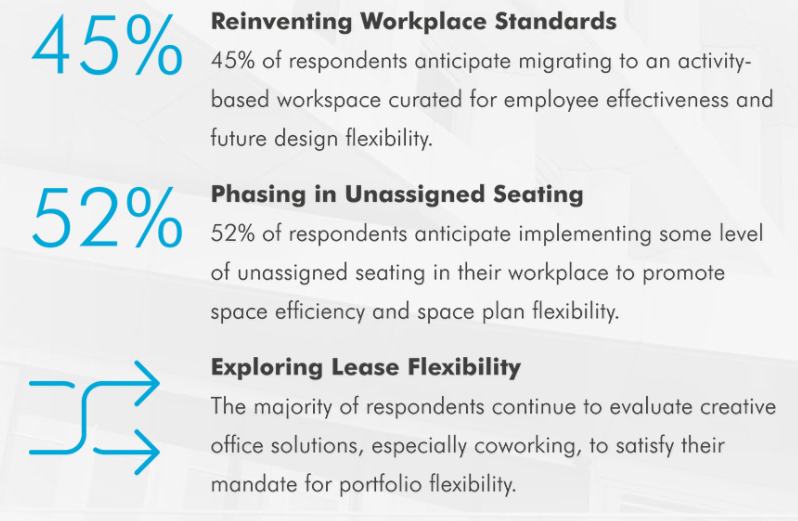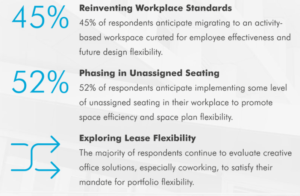

“The modern workplace is in a state of transition as workplace design standards have evolved from traditional layouts with a mix of enclosed and open workspaces. Flexibility over the life of a lease is one advantage to unassigned seating, as moves, adds and changes become significantly easier,” said Julie Whelan, Americas head of occupier research, CBRE. “Managing employees through this change is critical, so that the initiative is viewed as being additive to productivity and wellness instead of a pure cost-cutting measure.”
Today, about three out of four companies operate with a traditional, assigned-seating environment, the CBRE survey found. However, the survey respondents see their space plans changing dramatically over the next three years. Thirty-eight percent said they anticipate going to a partially unassigned seating environment, while 14 percent expect to adopt unassigned seating for everyone.
Other priorities for Americas executives in 2018 include preparing for the future workforce and the future corporate real estate team.
Future Workforce
While design is an integral component of a workplace of choice, supporting employees’ personal lives at work through ease and convenience is part of the transformative role that real estate is expected to play. Among the most important employee offerings, companies indicated amenities (81 percent), flexible work structure (44 percent) and access to public transportation (39 percent) as integral to creating a sought-after experience. The use of mobile apps to complement an employee’s experience at the office is expected to dramatically change — 59 percent anticipate implementing this technology in the next three to five years, compared to 23 percent using this technology today.
“Increasingly we are seeing occupiers adopt a service-driven approach to amenities, testing offerings like hospitality teams and wellness programs. This approach is inherently flexible, space efficient and easily tested in the workplace with little capital or commitment. This shift has allowed smaller occupiers — and large occupiers with distributed footprints — to offer amenities like food, fitness and health services through service that larger tenants have historically provided in dedicated fixed spaces. It has the potential to really level the playing field in the amenities race,” said Damla Gerhart, senior managing director and Americas lead of CBRE’s Workplace practice.
Future Corporate Real Estate Team
By creating and implementing strategies to create value in a changing environment, corporate real estate (CRE) executives have earned an elevated position in the C-Suite — 69 percent now report to a C-level position, up from 66 percent in 2017. To create value for the business, such as reducing portfolio costs and optimizing footprints, respondents showed a higher focus on data management and analytics (36 percent), enhanced user experience (32 percent) and driving CRE technology innovation (20 percent) in the mix of top 2018 goals compared to last year.
Read the full report on CBRE’s website.
